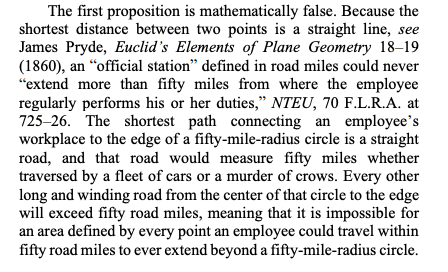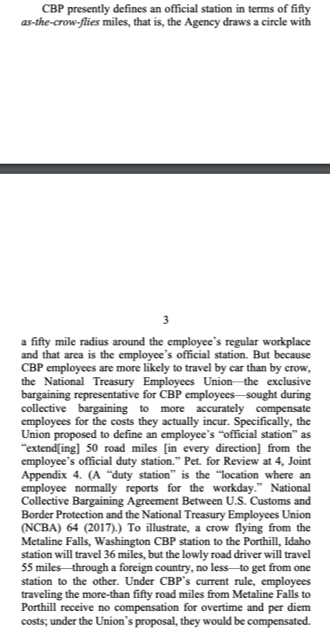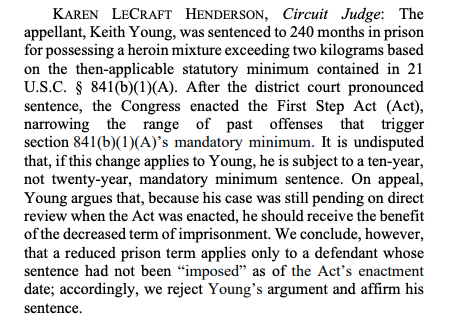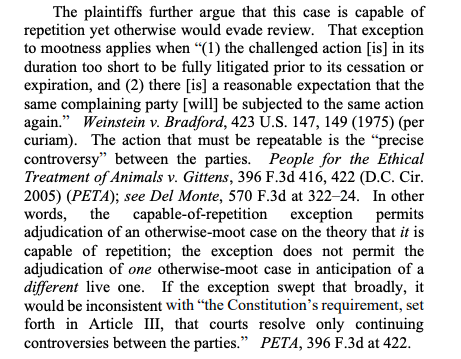D.C. Circuit Review – Reviewed: Euclidean
Sometimes the D.C. Circuit throws softballs to the commentariat. When Chief Judge Garland opened an opinion by referencing “Vincent Gambini,” it was obvious what I’d write about. When Judge Millett built an opinion around ingrates in the rodent community, my weekly post wrote itself. Ditto when Judge Randolph and Judge Srinivasan battled each other with literary references.
This was just such a week. After all, it is not every day you run across a passage like this:
Per Judge Tatel (joined by Judges Srinivasan and Ginsburg), here are the facts of National Treasury Employees Union v. FLRA. Federal employees receive compensation for legitimate work travel. But it has to be a real trip. Thus, each employee has an “official station” where he or she works. No part of that “station” can extend “more than 50 miles from where the employee regularly performs his or her duties.” The Customs and Border Protection “presently defines an official station in terms of fifty as-the-crow-flies miles, that is, the Agency draws a circle with a fifty mile radius around the employee’s regular workplace and that area is the employee’s official station.”
Here, “because CBP employees are more likely to travel by car than by crow,” the union wants a different formula — one that focuses on “road miles.” In particular, the union wants to define an employee’s station as extending 50 “road miles” from where the employee typically works, not 50 “crow” miles. As Judge Tatel put it:
The FLRA ruled against the union. One of the FLRA’s reasons, at least per the D.C. Circuit’s understanding of the record, is that it is possible that a test that uses 50 road miles may extend too far. The D.C. Circuit didn’t buy it. By definition, per Mr. Euclid, driving 50 miles on the road can never take you outside of “a fifty-mile-radius circle.”
Moving on, some physicists, steeped in math, believe it is possible “to use the curvature of space-time in the Universe to bend time into a circle.” It is really quite simple.* For instance, Professor Ben “Tippett created a mathematical model of a Traversable Acausal Retrograde Domain in Space-time (TARDIS). He describes it as a bubble of space-time geometry which carries its contents backward and forwards through space and time as it tours a large circular path. The bubble moves through space-time at speeds greater than the speed of light at times, allowing it to move backward in time.” Of course!
I mention time travel because of United States v. Young. Here is how Judge Henderson (joined by Judges Rogers and Edwards), opened her opinion:
Obviously, the defendant did not ask to travel back in time. Instead, he argued that a sentence is not “imposed” until judgment is reviewed “by the highest court authorized to review it.” The Court disagreed. Moreover, “disparities, reflecting a line-drawing effort, will exist whenever Congress enacts a new law changing sentences.”
Finally, is there also math in Planned Parenthood of Wisconsin v. Azar? Yes — the most basic math: two is more than one. Here, Judge Katsas, joined by Judge Sentelle, concluded over Judge Srinivasan’s (short) dissent that a challenge to a 2018 “Funding Opportunity Announcement (FOA) soliciting applications for family-planning grants” is moot because HHS “modified FOA for 2019, and amended the regulation.” And because the plaintiffs limited to their arguments to the 2018 FOA, they can’t “recast their suit as challenging ongoing HHS policies,” although they “remain free to challenge ongoing HHS policies in a separate action.” Judge Katsas also included this important paragraph:
One last thought. If you want some more math this week, here’s a puzzle: “Using only addition, how do you add eight 8’s and get the number 1000?”
* Not true.
D.C. Circuit Review – Reviewed is designed to help you keep track of the nation’s “second most important court” in just five minutes a week.







